Blackpool: Difference between revisions
Created page with '{{Infobox town |name=Blackpool |county=Lancashire |picture=Blackpool Tower from central pier ferris wheel .jpg |picture caption=Blackpool Tower and beach |os grid ref=SD306363 |l…' |
No edit summary |
||
| (4 intermediate revisions by 2 users not shown) | |||
| Line 2: | Line 2: | ||
|name=Blackpool | |name=Blackpool | ||
|county=Lancashire | |county=Lancashire | ||
|picture=Blackpool | |picture=Blackpool tower from central pier ferris wheel .jpg | ||
|picture caption=Blackpool Tower and beach | |picture caption=Blackpool Tower and beach | ||
|os grid ref=SD306363 | |os grid ref=SD306363 | ||
| Line 14: | Line 14: | ||
|constituency=Blackpool North and Cleveleys<br>Blackpool South | |constituency=Blackpool North and Cleveleys<br>Blackpool South | ||
}} | }} | ||
'''Blackpool''' is a large seaside town in [[Lancashire]]. It is stands on the sandy beaches of the [[Fylde]] peninsula, which is between the [[River Ribble|Ribble]] and [[River Wyre|Wyre]] estuaries, washed by the [[Irish Sea]]. Blackpool is the heart of the long pleasure coast of Lancashire, and of a conurbation formed | '''Blackpool''' is a large seaside town in [[Lancashire]]. It is stands on the sandy beaches of the [[Fylde]] peninsula, which is between the [[River Ribble|Ribble]] and [[River Wyre|Wyre]] estuaries, washed by the [[Irish Sea]]. Blackpool is the heart of the long pleasure coast of Lancashire, and of a conurbation formed along the coast as far as [[Fleetwood]]. | ||
In comparison with some Lancashire’s other great towns, Blackpool did not rise with industrial labour but with leisure, albeit leisure supplied to the mil owners and later to the mill workers. The town stands 17½ miles | In comparison with some Lancashire’s other great towns, Blackpool did not rise with industrial labour but with leisure, albeit leisure supplied to the mil owners and later to the mill workers. The town stands 17½ miles north-west of [[Preston]], 27 miles north of [[Liverpool]], 30 miles north-west of [[Bolton]] and 40 miles north-west of [[Manchester]]. | ||
Blackpool today has an estimated population of 140,000, making it one of Lancashire’s largest towns. | Blackpool today has an estimated population of 140,000, making it one of Lancashire’s largest towns. | ||
| Line 30: | Line 30: | ||
Blackpool gets its name from a historic drainage channel (possibly Spen Dyke) that ran over a peat bog, discharging discoloured water into the Irish Sea, which formed a black pool. Another explanation is that the local dialect for stream was "pul" or "poole", hence "Black poole". | Blackpool gets its name from a historic drainage channel (possibly Spen Dyke) that ran over a peat bog, discharging discoloured water into the Irish Sea, which formed a black pool. Another explanation is that the local dialect for stream was "pul" or "poole", hence "Black poole". | ||
By coincidence, on the other side of the [Irish Sea]], the city of [[Dublin]] derives its name from the Irish language ''Dubh Linn'', | By coincidence, on the other side of the [[Irish Sea]], the city of [[Dublin]] derives its name from the Irish language ''Dubh Linn'', meaning "black pool" | ||
People originating from Blackpool are called ''Sandgrown'uns,'' (as are persons originating from [[Morecambe]] and [[Southport]]) or ''Seasiders''. ''Blackpudlians'' is also (though rarely) used. | People originating from Blackpool are called ''Sandgrown'uns,'' (as are persons originating from [[Morecambe]] and [[Southport]]) or ''Seasiders''. ''Blackpudlians'' is also (though rarely) used. | ||
| Line 119: | Line 119: | ||
[[File:BlackpoolWinGar.JPG|thumb|TheWinter Gardens]] | [[File:BlackpoolWinGar.JPG|thumb|TheWinter Gardens]] | ||
[[File:CoralIslandBlackpool.jpg|thumb|Coral Island on Blackpool's Promenade]] | [[File:CoralIslandBlackpool.jpg|thumb|Coral Island on Blackpool's Promenade]] | ||
[[File:BlackpoolTN.JPG|thumb|275px|View from the tower, looking south]] | [[File:BlackpoolTN.JPG|thumb|275px|View from the tower, looking south]] | ||
*Blackpool Tower, opened in 1894; it has been a dominant landmark of the Blackpool skyline since that time. Inspired by the Eiffel Tower in Paris, France, it is 518 feet & 9 inches in height. Beneath the tower is a complex of leisure facilities, entertainment venues and restaurants, including the world famous Tower Ballroom and Tower Circus. | *Blackpool Tower, opened in 1894; it has been a dominant landmark of the Blackpool skyline since that time. Inspired by the Eiffel Tower in Paris, France, it is 518 feet & 9 inches in height. Beneath the tower is a complex of leisure facilities, entertainment venues and restaurants, including the world famous Tower Ballroom and Tower Circus. | ||
| Line 204: | Line 203: | ||
**AFC Blackpool | **AFC Blackpool | ||
**Blackpool Wren Rovers | **Blackpool Wren Rovers | ||
**Squires Gate | **Squires Gate | ||
*Rugby: Blackpool RUFC | *Rugby: Blackpool RUFC (whose home ground is Norbreck Rugby Ground) | ||
==Shipwrecks== | ==Shipwrecks== | ||
| Line 211: | Line 210: | ||
==Outside links== | ==Outside links== | ||
{{Commons | {{Commons}} | ||
*[http://www.visitblackpool.com Official Blackpool Tourism Website] | *[http://www.visitblackpool.com Official Blackpool Tourism Website] | ||
*[http://www.expedia.co.uk/Blackpool-Lancashire-Hotels.0-n6053792-0.Travel-Guide-Filter-Hotels Official Blackpool Tourism Hotel Website] | *[http://www.expedia.co.uk/Blackpool-Lancashire-Hotels.0-n6053792-0.Travel-Guide-Filter-Hotels Official Blackpool Tourism Hotel Website] | ||
| Line 220: | Line 219: | ||
==References== | ==References== | ||
{{reflist|2}} | {{reflist|2}} | ||
[[Category:Seaside resorts in Lancashire]] | [[Category:Seaside resorts in Lancashire]] | ||
Latest revision as of 20:31, 13 December 2016
| Blackpool | |
| Lancashire | |
|---|---|
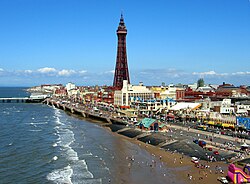 Blackpool Tower and beach | |
| Location | |
| Grid reference: | SD306363 |
| Location: | 53°49’7"N, 3°3’17"W |
| Data | |
| Population: | 140,000 (2010 est.) |
| Postcode: | FY0-4 |
| Local Government | |
| Council: | Blackpool |
| Parliamentary constituency: |
Blackpool North and Cleveleys Blackpool South |
Blackpool is a large seaside town in Lancashire. It is stands on the sandy beaches of the Fylde peninsula, which is between the Ribble and Wyre estuaries, washed by the Irish Sea. Blackpool is the heart of the long pleasure coast of Lancashire, and of a conurbation formed along the coast as far as Fleetwood.
In comparison with some Lancashire’s other great towns, Blackpool did not rise with industrial labour but with leisure, albeit leisure supplied to the mil owners and later to the mill workers. The town stands 17½ miles north-west of Preston, 27 miles north of Liverpool, 30 miles north-west of Bolton and 40 miles north-west of Manchester.
Blackpool today has an estimated population of 140,000, making it one of Lancashire’s largest towns.
The town
Throughout the Middle Ages and Early Modern period, Blackpool was a coastal hamlet in Lancashire's Amounderness Hundred, and remained such until the mid-18th century when summertime beach bathing became fashionable. In 1781, visitors attracted to Blackpool's 7 miles of sandy beach were able to use a newly-built private road, built by Thomas Clifton and Sir Henry Hoghton. Stagecoaches began running to Blackpool from Manchester in the same year, and from Halifax in 1782. In the early-19th century, Henry Banks and his son-in-law John Cocker erected new buildings in Blackpool such that its population grew from less than 500 in 1801 to over 2,500 in 1851. St John's Church in Blackpool was consecrated in 1821.
Blackpool rose to prominence as a major centre of tourism in England when a railway was built in the 1840s connecting it to the industrialised regions of northern England. The railway made it much easier and cheaper for visitors to reach Blackpool, triggering an influx of settlers, such that in 1876 Blackpool was incorporated as a borough governed by its own town council and aldermen. In 1881 Blackpool was a booming resort with a population of 14,000 and a promenade complete with piers, fortune-tellers, public houses, tram and donkey rides, fish-and-chip shops, theatres.[1] By 1901 the population of Blackpool was 47,000, by which time its place was cemented as "the archetypal British seaside resort".[1] By 1951 it had grown to 147,000.
Shifts in tastes and sensibilities, combined with opportunities for Britons to travel overseas, supplanted Blackpool's status as a leading resort during the late-20th century. Nevertheless, Blackpool's urban fabric and economy remains relatively undiversified, and firmly rooted in the tourism sector, and the borough's seafront continues to attract millions of visitors every year.[1] In addition to its sandy beaches, Blackpool's major attractions and landmarks include the Blackpool Tower, Blackpool Illuminations, the Pleasure Beach Blackpool, and the Winter Gardens.
Name of the town
Blackpool gets its name from a historic drainage channel (possibly Spen Dyke) that ran over a peat bog, discharging discoloured water into the Irish Sea, which formed a black pool. Another explanation is that the local dialect for stream was "pul" or "poole", hence "Black poole".
By coincidence, on the other side of the Irish Sea, the city of Dublin derives its name from the Irish language Dubh Linn, meaning "black pool"
People originating from Blackpool are called Sandgrown'uns, (as are persons originating from Morecambe and Southport) or Seasiders. Blackpudlians is also (though rarely) used.
History
Early history
A 12,000-year-old animal skeleton (the Carleton Elk) found with barbed arrowheads near Blackpool Sixth Form College in 1970 provided the first evidence of man on the Fylde, as far back as the Palaeolithic era.[2] In the Iron Age, the Fylde was also home to a British tribe, the Setantii (the "dwellers in the water") a sub-tribe of the Brigantes, who from about 80 AD were controlled by Romans from their fort at Dowbridge, Kirkham. During the Roman occupation the area was covered by oak forests and bog land.
Some of the earliest villages on the Fylde, which were later to become part of Blackpool town, were named in the Domesday Book in 1086. Many of them were Anglo-Saxon settlements. Some though were 9th and 10th century Viking place names. The Vikings and Anglo Saxons seem to have co-existed peacefully with some Anglo Saxon and Viking place names later being joined together – such as Layton-with-Warbreck and Bispham-with-Norbreck. Layton was controlled by the Butlers, Barons of Warrington from the 12th century.
In mediæval times Black Poole emerged as a few farmsteads on the coast within Layton-with-Warbreck. The name coming from "le pull" which was a stream that drained Marton Mere and Marton Moss into the sea close to what is now Manchester Square. The stream ran through peat lands which discoloured the water, and so the name for the area became Black Poole. In the 15th century the area was just called Pul. And a 1532 map calls the area "the pole howsys alias the north howsys”.
In 1602, entries in Bispham Parish Church baptismal register include both Poole and for the first time blackpoole. The first house of any substance, Foxhall, was built toward the end of the 17th century by Edward Tyldesley, the Squire of Myerscough, and son of the Royalist, Sir Thomas Tyldesley. An Act of Parliament in 1767 enclosed a common, mostly sand hills on the coast, that stretched from Spen Dyke southwards. Plots of the land were allocated to landowners in Bispham, Layton, Great Marton and Little Marton. The same act also provided for the layout of a number of long straight roads that would be built such as Lytham Road, St.Annes Road and Highfield Road.[3]
Taking the cure
By the middle of the 18th century, the practice of sea bathing to cure diseases was beginning to become fashionable among the wealthier classes, and visitors began making the arduous trek to Blackpool for that purpose. In 1781 Thomas Clifton and Sir Henry Hoghton built a private road to Blackpool, and a regular stagecoach service from Manchester and Halifax was established. A few amenities, including four hotels, an archery stall and bowling greens, were developed, and the town grew slowly. The 1801 census records the town's population at 473.
The growth was accelerated by the actions of Henry Banks, often considered to be the “Father of Blackpool”. In 1819 he purchased the Lane Ends estate, including the Lane Ends Hotel and built the first holiday cottages. In 1837, his son-in-law Dr. John Cocker built Blackpool’s first assembly rooms, which still stand on the corner of Victoria Street and Bank Hey Street.
Arrival of the railways
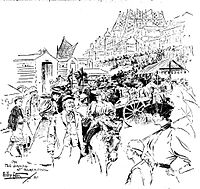
The most significant event in the early growth of the town occurred in 1846, with the completion of a branch line to Blackpool from Poulton on the main Preston and Wyre Joint Railway line from Preston to Fleetwood. Fleetwood declined as a resort, as its founder and principal financial backer, Peter Hesketh-Fleetwood went bankrupt. In contrast, Blackpool boomed. A sudden influx of visitors, arriving by rail, provided the motivation for entrepreneurs to build accommodations and create new attractions, leading to more visitors and a rapid cycle of growth throughout the 1850s and 1860s. In 1851 a Board of Health was formed. Gas lighting was introduced in 1852, and piped water in 1864. By 1851, the town's population was over 2500.
The growth was intensified by the practice among the Lancashire cotton mill owners to close the factories for a week every year to service and repair machinery. These became known as wakes weeks. Each town's mills would close for a different week, allowing Blackpool to manage a steady and reliable stream of visitors over a prolonged period in the summer.
In 1863, the North Pier was completed, rapidly becoming a centre of attraction for elite visitors. Central Pier was completed in 1868, with a theatre and a large open-air dance floor. The town expanded southward beyond what is today known as the Golden Mile, towards South Shore, and South Pier was completed in 1893, making Blackpool the only town in the United Kingdom with three piers. In 1878, the Winter Gardens complex opened, incorporating ten years later the Opera House, said to be the largest in Britain outside London.
The town was granted a Charter of Incorporation as a municipal borough in 1876. WH Cocker, son of Dr John Cocker, and therefore grandson of Henry Banks, was its first mayor. The town would become a county borough in 1904.
Electricity
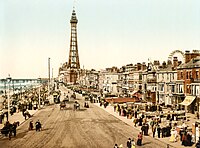
Much of Blackpool's growth and character from the 1870s on was predicated on the town's pioneering use of electrical power. In 1879, it became the first municipality in the world to have electric street lighting, as large parts of the promenade were wired. The lighting and its accompanying pageants reinforced Blackpool's status as the North's most prominent holiday resort, and its specifically working class character. It was the forerunner of the present-day Blackpool Illuminations. In 1885 one of the world's first electric tramways was laid down as a conduit line running from Cocker Street to Dean Street on the Promenade. The line was operated by the Blackpool Electric Tramway Company until 1892 when their lease expired and Blackpool Corporation took over running the line. A further line was added in 1895 from Manchester Square along Lytham Road to South Shore, and the line was extended north, first to Gynn Square in 1899, and then to Fleetwood. In 1899 the conduit system was replaced by overhead wires. The tramway has remained in continuous service to this day.
By the 1890s, the town had a population of 35,000, and could accommodate 250,000 holidaymakers. The number of annual visitors, many staying for a week, was estimated at three million. 1894 saw the opening of two of the town's most prominent buildings; the Blackpool Grand Theatre on Church Street, and Blackpool Tower on the Promenade. The Blackpool Grand Theatre was also one of Britain's first all-electric theatres.
The first decade of the new century saw the development of the Promenade as we know it today, and further development southwards beyond South Shore towards Harrowside and Squires Gate. The Pleasure Beach was first established about this time. Seasonal static illuminations were first set up in 1912, although due to First World War and its aftermath, they only enjoyed two seasons until they were re-introduced in 1925. The illuminations extended the holiday season into September and early October.
Towards the present
The inter-war period saw Blackpool attain pre-eminence as a holiday destination. By 1920, Blackpool claimed around eight million visitors per year, three times as many as its nearest British rivals, still drawn largely from the mill towns of Lancashire and of the West Riding of Yorkshire. Stanley Park was laid out in 1920 and opened in 1926. The area round the park has become renowned for some of the most desirable residences in the area.
In 1937, Littlewoods opened its first department store in the town.[4]
Documents have been found to suggest that the reason Blackpool escaped heavy damage in Second World War was that Adolf Hitler had earmarked the town to remain a place of leisure after his planned invasion.[5] Despite this, on 11 September 1940, German bombs fell near the North railway station and eight people were killed in nearby houses.
Blackpool's population boom was complete by 1951, by which time some 147,000 people were living in the town - compared to 47,000 in 1901 and a mere 14,000 in 1881.[6] In the decade after the war, the town continued to attract more visitors, reaching a zenith of 17 million per year. However, several factors combined to make this growth untenable. The decline of the textile industry led to a de-emphasis of the traditional week-long break. The rise of package holidays took many of Blackpool's traditional visitors abroad, where the weather was more reliably warm and dry, and improved road communications, epitomised by the construction of the M55 motorway in 1975, made Blackpool more feasible as a day trip rather than an overnight stay. The economy, however, remains relatively undiversified, and firmly rooted in the tourism sector.
Tourism
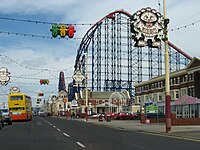
Blackpool is heavily dependent on tourism. In what is often regarded as its heyday (1900–1950), Blackpool thrived as the factory workers of northern England took their annual holidays there en masse. Any photograph from that era shows crowds of tourists on the beach and promenade. Blackpool was also a preferred destination of visitors from Glasgow and remains so to this day.[7] The town went into decline when cheap air travel arrived in the 1960s and the same workers decamped to the Mediterranean coastal resorts due to competitive prices and the more reliable weather.[8] Today Blackpool remains the most popular seaside resort in the UK, however the town has suffered a serious drop in numbers of visitors which has fallen from 17 million in 1992 to 10 million today.[9] Similarly Pleasure Beach Blackpool was the country's most popular free attraction with 6 million visitors a year but has lost over a million visitors since 1998 and has recently introduced a £5 entrance fee. Today, many visitors stay for the weekend rather than for a week at a time.

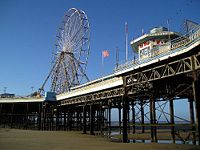
In July 2010, an independent survey of 4500 members of the general public by consumer magazine Which? Holiday found that Blackpool is the UK's all-time favourite seaside resort, followed by Brighton, Whitby, Bournemouth and Scarborough. Fans love the special atmosphere in the town, as well as the spectacular annual illuminations which were described by one respondent as “simply breathtaking”. Blackpool has now improved the seawall and promenade and in addition to that Blackpool Tower has had a revamp.
Conferences
Outside the main holiday season, Blackpool's Winter Gardens routinely hosts major political and trade union conferences, ranging from that of the Conservative Party and the Transport and General Workers Union with thousands of delegates and visitors, to substantially smaller gatherings such as the Communication Workers Union conference. The Labour Party though, now uses facilities in Manchester when, every alternate year, its annual conference is in the North.
Entertainment
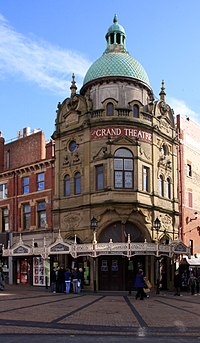
Blackpool remains a summer entertainment venue, specialising in variety shows featuring entertainers such as Ken Dodd and Roy 'Chubby' Brown. Ken Dodd can regularly be seen throughout late summer at the Grand Theatre, Blackpool.
The Grand Theatre, Blackpool was designed by Victorian theatre architect Frank Matcham and was opened in 1894 after a construction period of seven months, at a cost of £20,000 between December 1893 and July 1894. The project was conceived and financed by local theatre manager Thomas Sergenson who had been using the site of the Grand for several years to stage a circus. He had also transformed the fortunes of other local theatres.
Matcham's brief was to build Sergenson the "prettiest theatre in the land". The Grand was Matcham's first theatre to use an innovative 'cantilever' design to support the tiers, thereby reducing the need for the usual pillars and so allowing clear views of the stage from all parts of the auditorium.
Sergenson's successful directorship of the theatre ended in 1909 when he sold the operation to the Blackpool Tower Company for a considerable profit.
The success of the Grand continued through First World War and on until the 1930s. The theatre now faced stiff competition from the newly introduced talking movies and the building was operated as a cinema outside the summer tourist season. This practice continued until 1938 when the nearby Opera House was constructed.
The Grand was able to stay open during Second World War but the post-war rise in the popularity of television was probably the cause of the theatre's dwindling popularity toward the 1960s. Plans were filed for the demolition of the historic site in 1972 but the Grand's status as a Grade II* listed building was sought and obtained by a group of friends, thereby preventing this from taking place. An agreement was reached with the Grand's owners, EMI, that a refurbishment of the then unused building would take place if it could be used as a bingo hall. After three years of bingo use, the group of friends, now called the Friends of the Grand, with the support of Blackpool Borough Council negotiated to lease and eventually buy the theatre back from EMI over a period of a few years. The purchase was complete by 1 October 1980 and a refurbishment, achieved partly through voluntary effort, was begun. Finally, on 23 March 1981 the Grand re-opened as a theatre once again to stage an Old Vic performance of William Shakespeare's The Merchant of Venice featuring Timothy West and Prunella Scales. The theatre's return was further confirmed in May of the same year when a Royal Variety Performance was staged in the presence of Charles, Prince of Wales.
Events and festivals
- Blackpool Dance Festival is a world famous annual ballroom dance competition of international significance[10] (as featured in the 2004 film Shall We Dance?
- For the last three years, Blackpool has played host to the Rebellion Punk Rock Festival, an annual event which moved back to Blackpool after a few years in nearby Morecambe[11]
- Blackpool Illuminations consisting of a series of lighted displays and collages arranged along the entire length of the sea front, seven miles in total, attract many visitors from late August to early November; a time when most British seaside resorts' holiday seasons have already ended. 2009's festival dates are 4 Sep 2009 – 8 Nov 2009. This results in some spectacular traffic snarl-ups as most people now view the lights from cars and coaches which crawl nose-to-tail along the whole length of the sea front, particularly so at weekends and during school holidays. Each season a famous person "flicks the switch" to turn the lights on in an opening night switch on ceremony. The BBC Top Gear team had a race to see who could arrive first from France on a limited amount of fuel (James May who was last missed it), to activate the lights for 2008.
Landmarks & places of interest
Blackpool boasts some important landmarks, most of which appeared originally as part of the flourishing tourist industry.
Major attractions
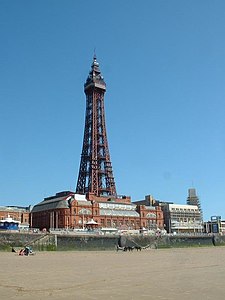
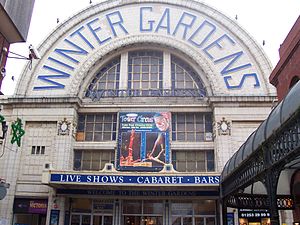
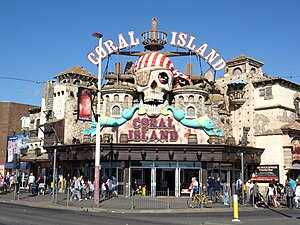
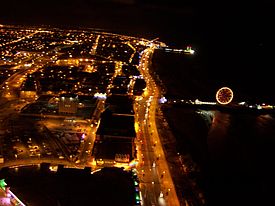
- Blackpool Tower, opened in 1894; it has been a dominant landmark of the Blackpool skyline since that time. Inspired by the Eiffel Tower in Paris, France, it is 518 feet & 9 inches in height. Beneath the tower is a complex of leisure facilities, entertainment venues and restaurants, including the world famous Tower Ballroom and Tower Circus.
- North Pier – The northernmost of Blackpool's three piers. It includes a small shopping arcade, a small tramway and the North Pier Theatre toward the end of the pier. The pier end also used to have a helicopter pad, but this was damaged in a Christmas storm in 1997 and collapsed into the sea.
- Grand Theatre (Frank Matcham Theatre) built in 1894. Offers an eclectic mix of drama, dance, opera, ballet and comedy including a yearly Pantomime.
- Central Pier – The middle pier, includes a large Ferris wheel and shops.
- South Pier – The southernmost pier. Almost directly opposite the Pleasure Beach, it houses a theme park.
- Pleasure Beach Blackpool – An amusement park with rides including the Pepsi Max Big One, which was the world's fastest and tallest complete circuit rollercoaster between 1994 and 1996.
- The Winter Gardens is a large entertainment and conference venue in the town centre. It includes the Opera House (one of the largest theatres in Europe), Pavilion Theatre, Empress Ballroom, Spanish Hall, Arena and Olympia.
- The Comedy Carpet – a 23,680 square-foot installation in front of the Blackpool Tower, containing jokes and catchphrases of more than 1,000 comedians and comedy writers from the early days of variety to the present, in over 160,000 granite letters embedded into concrete
- Stanley Park – Grade II historic park and gardens with golf course, cricket club, sports arena, lake, art deco restaurant, model village, gardens, etc.
Other attractions
- Beach – Stretching along the whole seafront. The main natural attraction for tourists.
- Blackpool Zoo – provides a home to over 1,500 animals from all over the world.
- Grand Theatre –Victorian theatre designed by Frank Matcham. Also now known as the National Theatre of Variety.
- Great Promenade Show – Series of modern artwork installations along Blackpool's South Promenade. Includes the Blackpool High Tide Organ an unusual musical monument which uses the movements of the sea to make music.
- Madame Tussaud's Waxworks – waxwork museum, featuring models of celebrities, musicians, sports personalities and a Chamber of Horrors.
- Sandcastle Water Park – UK's largest indoor waterpark home to 18 slides and attractions including the largest indoor rollercoaster waterslide in the world - 'The Masterblaster'. And the first indoor 'Sidewinder' in the world. Two new slides are currently being built- Aztec Falls(a bowl slide) and Montazooma (a mat slide.
- Odeon Cinema – Situated on a multi-complex site, on Rigby Road, with 10 screens.
- Sea Life Centres - a large aquarium featuring a walkthrough shark tank, located on the Promenade near Central Pier.
Blackpool in film
Blackpool has appeared in film and television many times. Some noteworthy film appearances include:
- Sing as We Go (1934), starring Gracie Fields
- Forbidden (1949)
- Hindle Wakes (1952)
- Holiday (1957)
- Coasting (television, 1990)
- Funny Bones (1995) starring Lee Evans
- The Parole Officer (2001) starring Steve Coogan
- Shall We Dance (1996), a Japanese film, closes with a scene at the World Ballroom Dancing Championships in Blackpool
- Bhaji on the Beach (1993)
- Like It Is (1998)
- Funland (television, 2005) revolved around the fictionalized, seedier aspects of Blackpool
The town also features heavily in the BBC television serial Blackpool first broadcast in 2004 along with the one-off follow-up Viva Blackpool, broadcast in June 2006.
In 2006 Lion Television filmed 'The Great British Summer' and featured many popular iconic buildings in Blackpool. The Royal Windsor Hotel was also featured with the owner Bob Hope talking all about the hotel seasons and industry. Bernard Manning was also shown at the hotel doing his spot through the season hosted by a local DJ (BMD) and other local acts. 'The Great British Summer' was narrated by Alan Titchmarsh.
Churches
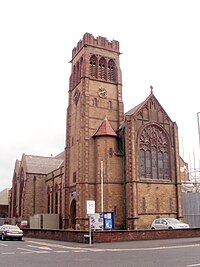
Blackpool has a number of Christian churches including:
- Church of England:
- Baptist:
- Several churches
- Congregational: Victoria Congregational Church
- Independent evangelical:
- Blackpool Christian Centre
- Blackpool Community Church
- Blackpool and Fylde Church
- Kings Christian Centre
- Liberty Church, (Metropolitan Community Church)
- New Life Community Church
- Methodist:
- Roman Catholic: 10 churches.
The Blackpool Faith Forum was established in 2001 in conjunction with Blackpool Council to provide interfaith dialogue between the various faith groups in the town, to raise awareness of the various faiths in the town and to promote a multifaith community. In February 2007 a youth forum was established, Blackpool Faith Forum for Youth.
Media
- Newspapers:
- Blackpool Gazette
- Blackpool Reporter (free, delivered)
- Lancashire Evening Post
- Radio:
- Radio Wave 96.5
- BBC Radio Lancashire
- Rock FM
- Magic 999
- Smooth FM 100.4
- 105.4 Real Radio (North West)
Sport
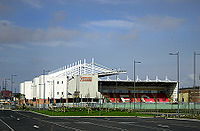
- Boxing: The Tower Circus Arena held regular professional boxing shows for a number of years. However, for many years boxing shows have been few and far between in the town, with events being promoted on an irregular basis including one in 2005 at the Hilton Hotel.
- Cricket: Blackpool Cricket Club are Blackpool's major cricketing team. Their home is in the grounds of Stanley Park.
- Football:
- Blackpool FC are a professional side. They joined the Premier League for the first time in 2010–11 and won the 1953 FA Cup Final
- AFC Blackpool
- Blackpool Wren Rovers
- Squires Gate
- Rugby: Blackpool RUFC (whose home ground is Norbreck Rugby Ground)
Shipwrecks
A number of shipwrecks have occurred on the coastline of Blackpool. The most recent occurrence has been the grounding of the MS Riverdance in January, 2008. Famously, in 1897, HMS Foudroyant, (Nelson's flagship before he moved his flag to the Victory) was grounded in a storm close to where the North Pier now stands.
Outside links
| ("Wikimedia Commons" has material about Blackpool) |
- Official Blackpool Tourism Website
- Official Blackpool Tourism Hotel Website
- Official Lancashire and Blackpool Tourist information
- Fylde coast marine life project
- 4 Star Hotels in Blackpool
- Blackpool Council
References
- ↑ 1.0 1.1 1.2 Andrews et al. 2002, p. 597.
- ↑ "Who were the Setantii?". amounderness.com. http://www.amounderness.com/site/setantii.htm. Retrieved 2008-01-26.
- ↑ "Blackpool History" (PDF). Blackpool Tourist Office. Archived from the original on July 5, 2007. http://web.archive.org/web/20070705082737/http://www.blackpooltourism.com/resources/files/2_Blackpool+History.pdf. Retrieved 2007-03-18.
- ↑ "Jobs to go as Index stores close". BBC News. 2005-04-19. http://news.bbc.co.uk/1/hi/business/4453681.stm.
- ↑ Waterhouse, Keith (2009-02-25). "Daily Mail". London: Mail Online. http://www.dailymail.co.uk/debate/article-1155666/KEITH-WATERHOUSE-If-Hitler-got-Golden-Mile.html. Retrieved 2009-02-27.
- ↑ http://www.localhistories.org/blackpool.html
- ↑ Nevin, Charles (2003-05-11). "A Writer At Large: Blackpool: The Last Resort". The Independent on Sunday. p. 5. http://web.archive.org/web/20070311001405/findarticles.com/p/articles/mi_qn4159/is_20030511/ai_n12739457/pg_5. Retrieved 2010-09-30.
- ↑ Alan Cowell, Postcard From Ailing British Coasts: Wish You Were Here, The New York Times, 12 April 2007.
- ↑ Parkinson, Dan (2007-01-30). "Blackpool: 'It's like someone has died'". BBC News. http://news.bbc.co.uk/2/hi/uk_news/england/lancashire/6313439.stm. Retrieved 2010-04-26.
- ↑ BlackpoolDanceFestival.net – [Frontpage]
- ↑ Rebellion Festivals – Home
